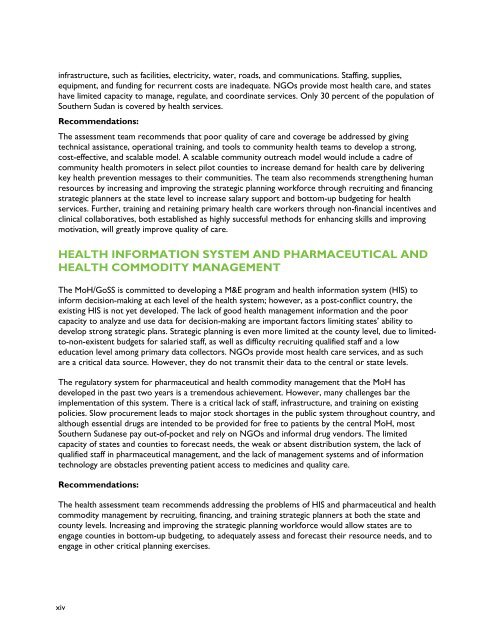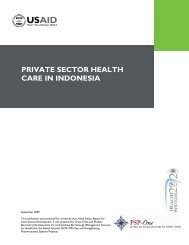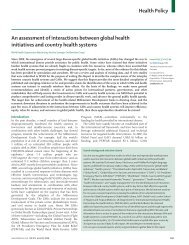southern sudan health system assessment - Health Systems 20/20
southern sudan health system assessment - Health Systems 20/20
southern sudan health system assessment - Health Systems 20/20
You also want an ePaper? Increase the reach of your titles
YUMPU automatically turns print PDFs into web optimized ePapers that Google loves.
infrastructure, such as facilities, electricity, water, roads, and communications. Staffing, supplies,<br />
equipment, and funding for recurrent costs are inadequate. NGOs provide most <strong>health</strong> care, and states<br />
have limited capacity to manage, regulate, and coordinate services. Only 30 percent of the population of<br />
Southern Sudan is covered by <strong>health</strong> services.<br />
Recommendations:<br />
The <strong>assessment</strong> team recommends that poor quality of care and coverage be addressed by giving<br />
technical assistance, operational training, and tools to community <strong>health</strong> teams to develop a strong,<br />
cost-effective, and scalable model. A scalable community outreach model would include a cadre of<br />
community <strong>health</strong> promoters in select pilot counties to increase demand for <strong>health</strong> care by delivering<br />
key <strong>health</strong> prevention messages to their communities. The team also recommends strengthening human<br />
resources by increasing and improving the strategic planning workforce through recruiting and financing<br />
strategic planners at the state level to increase salary support and bottom-up budgeting for <strong>health</strong><br />
services. Further, training and retaining primary <strong>health</strong> care workers through non-financial incentives and<br />
clinical collaboratives, both established as highly successful methods for enhancing skills and improving<br />
motivation, will greatly improve quality of care.<br />
HEALTH INFORMATION SYSTEM AND PHARMACEUTICAL AND<br />
HEALTH COMMODITY MANAGEMENT<br />
The MoH/GoSS is committed to developing a M&E program and <strong>health</strong> information <strong>system</strong> (HIS) to<br />
inform decision-making at each level of the <strong>health</strong> <strong>system</strong>; however, as a post-conflict country, the<br />
existing HIS is not yet developed. The lack of good <strong>health</strong> management information and the poor<br />
capacity to analyze and use data for decision-making are important factors limiting states’ ability to<br />
develop strong strategic plans. Strategic planning is even more limited at the county level, due to limitedto-non-existent<br />
budgets for salaried staff, as well as difficulty recruiting qualified staff and a low<br />
education level among primary data collectors. NGOs provide most <strong>health</strong> care services, and as such<br />
are a critical data source. However, they do not transmit their data to the central or state levels.<br />
The regulatory <strong>system</strong> for pharmaceutical and <strong>health</strong> commodity management that the MoH has<br />
developed in the past two years is a tremendous achievement. However, many challenges bar the<br />
implementation of this <strong>system</strong>. There is a critical lack of staff, infrastructure, and training on existing<br />
policies. Slow procurement leads to major stock shortages in the public <strong>system</strong> throughout country, and<br />
although essential drugs are intended to be provided for free to patients by the central MoH, most<br />
Southern Sudanese pay out-of-pocket and rely on NGOs and informal drug vendors. The limited<br />
capacity of states and counties to forecast needs, the weak or absent distribution <strong>system</strong>, the lack of<br />
qualified staff in pharmaceutical management, and the lack of management <strong>system</strong>s and of information<br />
technology are obstacles preventing patient access to medicines and quality care.<br />
Recommendations:<br />
The <strong>health</strong> <strong>assessment</strong> team recommends addressing the problems of HIS and pharmaceutical and <strong>health</strong><br />
commodity management by recruiting, financing, and training strategic planners at both the state and<br />
county levels. Increasing and improving the strategic planning workforce would allow states are to<br />
engage counties in bottom-up budgeting, to adequately assess and forecast their resource needs, and to<br />
engage in other critical planning exercises.<br />
xiv
















